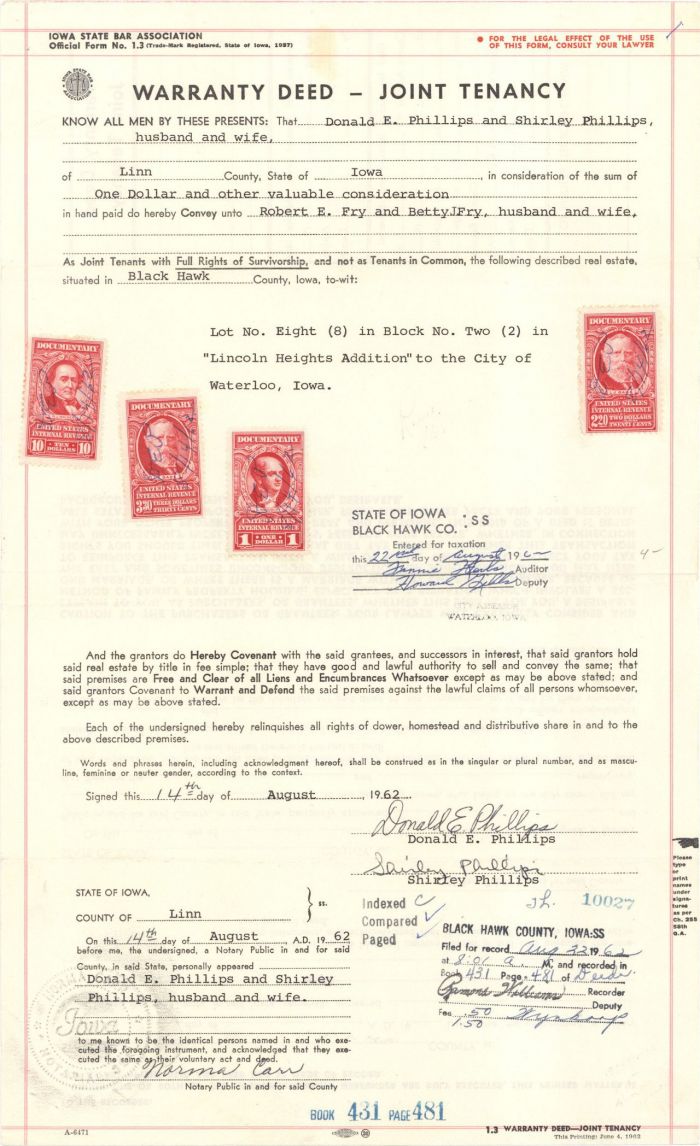Warranty Deed - Joint Tenancy - Americana
Inv# AM1909
Warranty Deed with 4 red revenue stamps. Waterloo, Iowa.
A warranty deed is a type of deed where the grantor (seller) guarantees that they hold clear title to a piece of real estate and has a right to sell it to the grantee (buyer), in contrast to a quitclaim deed, where the seller does not guarantee that they hold title to a piece of real estate. A general warranty deed protects the grantee against title defects arising at any point in time, extending back to the property's origins. A special warranty deed protects the grantee only against title defects arising from the actions or omissions of the grantor.
A warranty deed can include six traditional forms of Covenants for Title, sometimes known as the English covenants of title. Those six traditional forms of covenants can be broken down into two categories: present covenants and future covenants.
- Present Covenants
- Covenant of Seisin: "A covenant of seisin or good right to convey."
- Covenant of Right to Convey: Covenants that represent the seller's promise that they have a valid title of the property being conveyed and have not contracted to sell it to another.
- Covenant Against Encumbrances: Seller promises that there are no encumbrances, other than those that have been previously disclosed.
- Future Covenants
- Covenant of Quiet Enjoyment: "The covenant of warranty is an assurance or guarantee of title, or an agreement or assurance by the grantor of an estate that the grantee and their heirs and assigns will enjoy it without interruption by virtue of a paramount title and that they will not, by force of a paramount title, be evicted from the land or deprived of its possession. . . ."
- Covenant of Warranty: Covenants that represent seller's promise to protect the buyer against anyone who comes along later and claims paramount title to the property.
- Covenant of Further Assurances: The covenant of further assurances requires the seller to take affirmative steps to cure any defects in the grantor's title.
Most buyers perform a title search to determine if there are defects in title that must be resolved before they purchase real property. A title search provides constructive notice of any encumbrances, easements, or restrictions on the property being conveyed, and is generally considered part of a buyer's due diligence in the process of purchasing real estate. Buyers can also purchase title insurance to protect against title defects. A warranty deed is not a substitute for title insurance because, if the grantor later dies or goes bankrupt, the grantee may not be able to exercise the warranty.
Waterloo was originally known as Prairie Rapids Crossing. The town was established near two Meskwaki American tribal seasonal camps alongside the Cedar River. It was first settled in 1845 when George and Mary Melrose Hanna and their children arrived on the east bank of the Red Cedar River (now just called the Cedar River). They were followed by the Virden and Mullan families in 1846. Evidence of these earliest families can still be found in the street names Hanna Boulevard, Mullan Avenue and Virden Creek.
On December 8, 1845, the Iowa State Register and Waterloo Herald was the first newspaper published in Waterloo.
The name Waterloo supplanted the original name, Prairie Rapids Crossing, shortly after Charles Mullan petitioned for a post office in the town. Since the signed petition did not include the name of the proposed post office location, Mullan was charged with selecting the name when he submitted the petition. Tradition has it that as he flipped through a list of other post offices in the United States, he came upon the name Waterloo. The name struck his fancy, and a post office was established under that name. There were two extended periods of rapid growth over the next 115 years. From 1895 to 1915, the population increased from 8,490 to 33,097, a 290% increase. From 1925 to 1960, population increased from 36,771 to 71,755. The 1895 to 1915 period was a time of rapid growth in manufacturing, rail transportation and wholesale operations. During this period the Waterloo Gasoline Traction Engine Company moved to Waterloo and, shortly after, the Rath Packing Company moved from Dubuque. Another major employer throughout the first two-thirds of the 20th century was the Illinois Central Railroad. Among the others was the less-successful brass era automobile manufacturer, the Maytag-Mason Motor Company.
On June 7, 1934, bank robber Tommy Carroll had a shootout with the FBI when he and his wife stopped to pick up gas. Accidentally parking next to a police car and wasting time dropping his gun and picking it back up, Carroll was forced to flee into an alley, where he was shot. He was taken to Allen Memorial Hospital in Waterloo, where he soon died.
Waterloo suffered in the agricultural recession of the 1980s; its major employers at the time were heavily rooted in agriculture. John Deere, the area's largest employer, cut 10,000 jobs, and the Rath meatpacking plant closed altogether, losing 2,500 jobs. It is estimated that Waterloo lost 14% of its population during this time. Today the city enjoys a broader industrial base, as city leaders have sought to diversify its industrial and commercial mix. Deere remains a strong presence in the city, but employs only roughly one-third the number of people it did at its peak.










Ebay ID: labarre_galleries